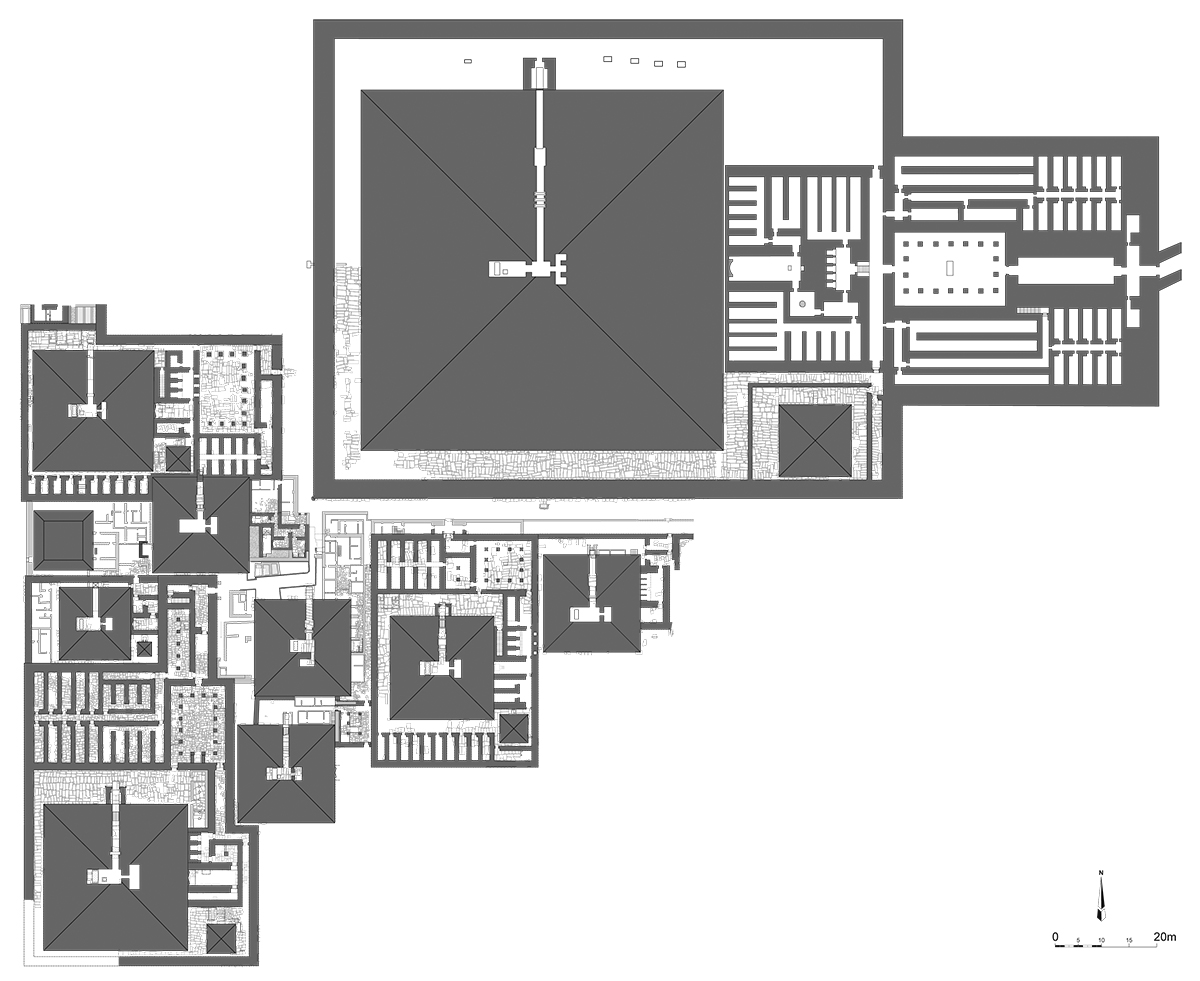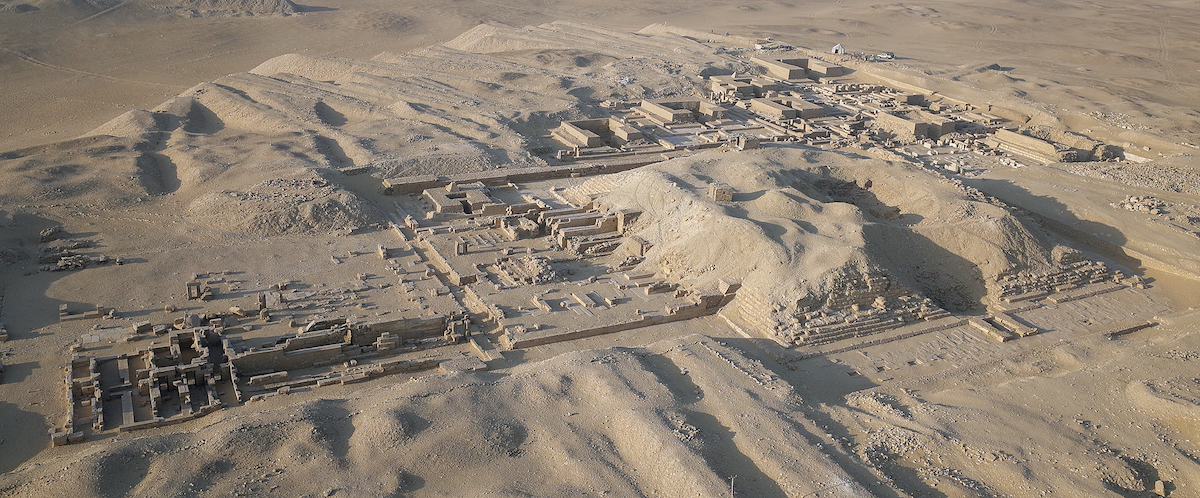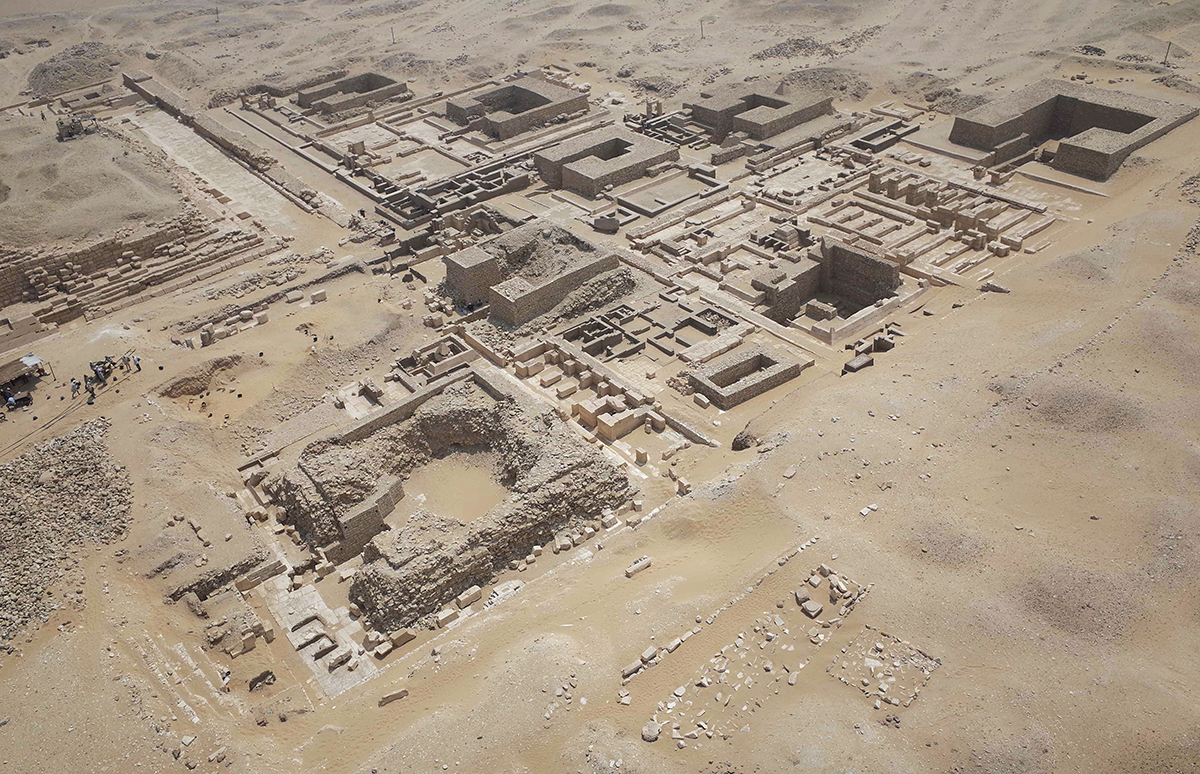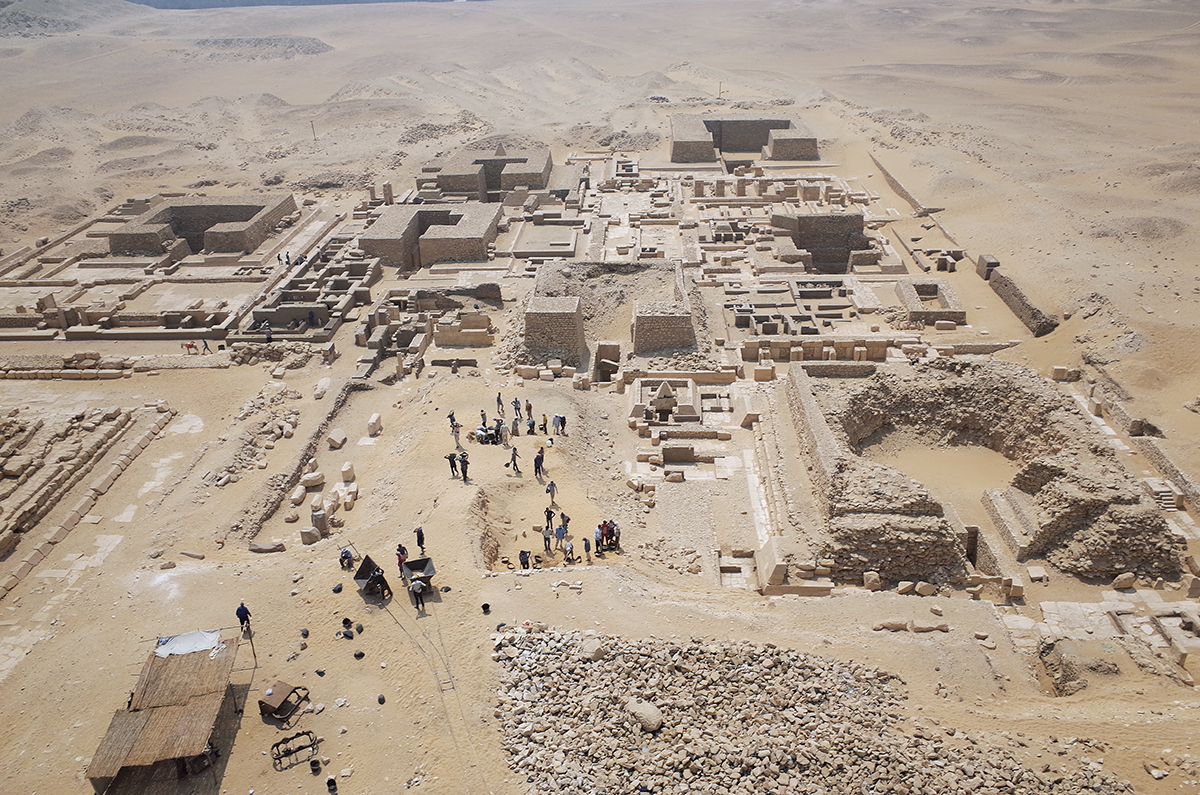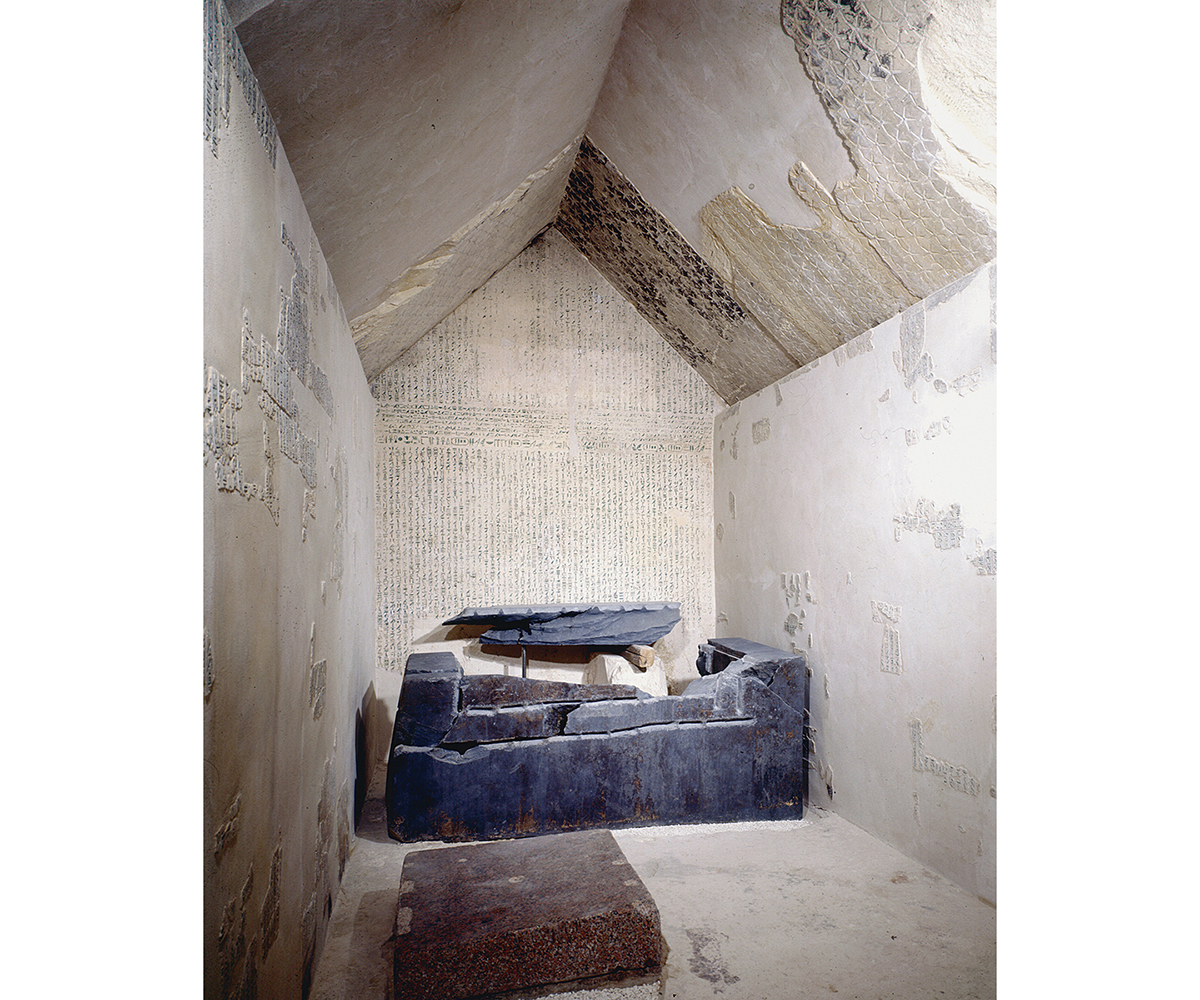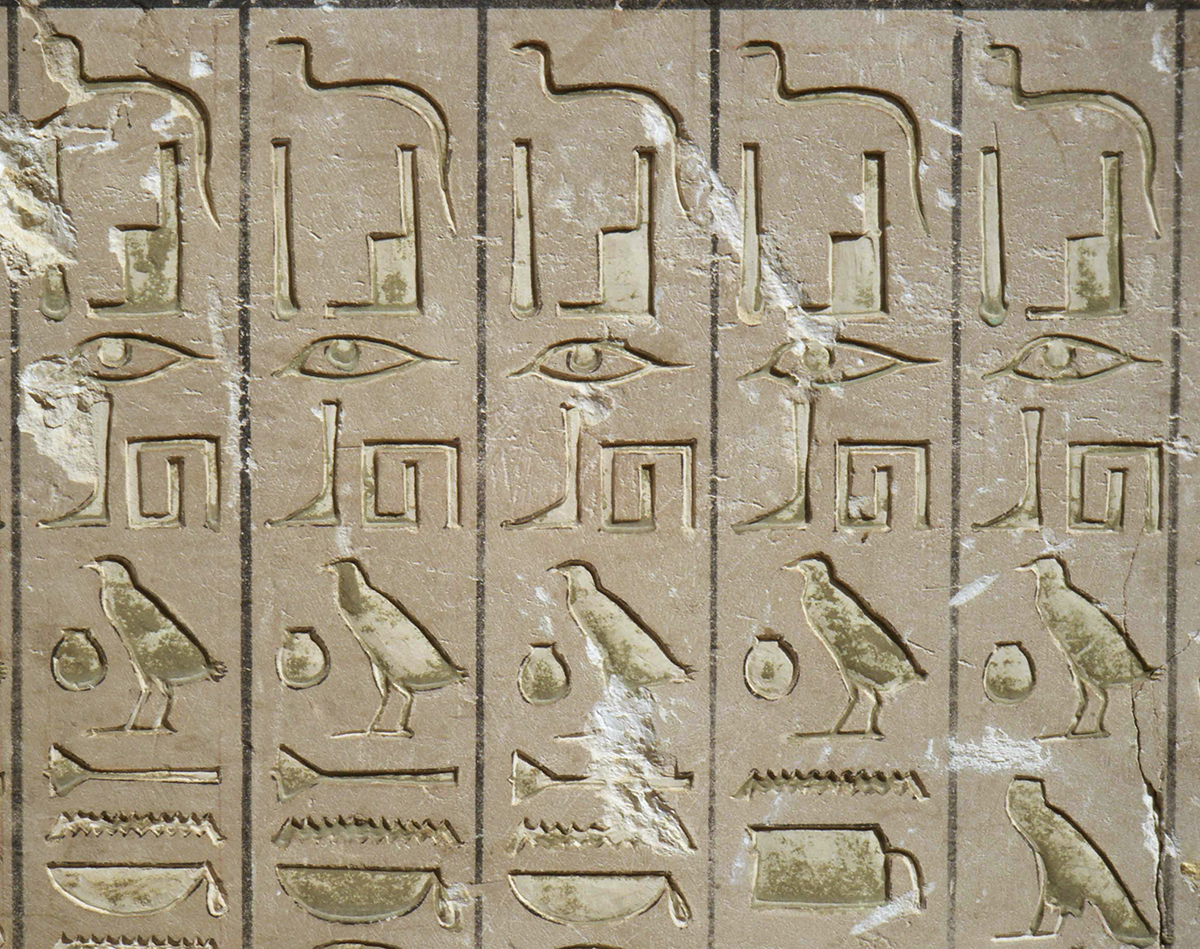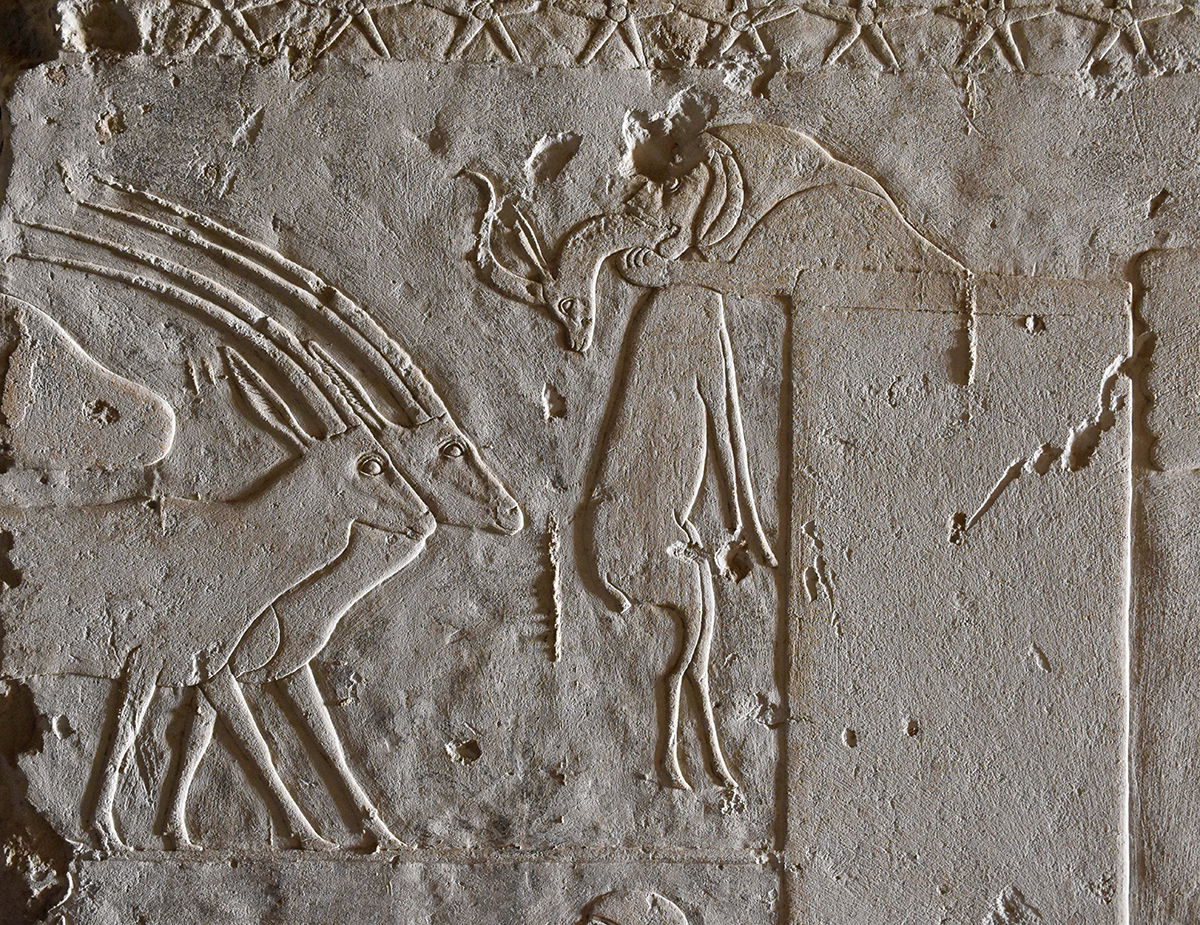Saqqara
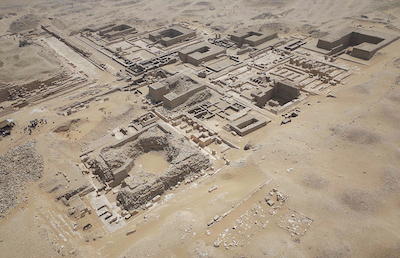
 doi doi | 10.34816/ifao.8923-42bc |
 IdRef IdRef | 031783031 |
Mission Archéologique Franco-suisse de Saqqara-Sud (MAFS) pour le chantier archéologique de la nécropole royale de Pépy IOpération de terrain 18120
Responsable(s)
Partenaires
Cofinancements
Dates des travaux
novembre - décembre
Rapports de fouilles dans le BAEFE
2022 : 10.4000/baefe.8815
2021 : 10.4000/baefe.5530
2019 : 10.4000/baefe.1061
➣ Site(s) de la mission
http://mafssaqqara.wixsite.com/mafs
Participants en 2026
Gravés sur les parois des appartements funéraires des pyramides de la fin de la Ve à la VIIIe dynastie (env. 2350-2150 av. J.-C.), ces Textes des Pyramides sont composés de centaines de formules destinées à la survie du roi dans l’au-delà et fourmillent de mentions de dieux, lieux, concepts, objets, etc. qui nous permettent de toucher du doigt les plus anciennes conceptions religieuses de l’humanité textuellement conservées.
Dirigée par Audran Labrousse jusqu’en 2007, la MafS est devenue Mission archéologique franco-suisse de Saqqara en 2015 et est désormais sous la responsabilité de Philippe Collombert, professeur à l’université de Genève.
Les travaux de la MafS impliquent l’étude, la restauration et la publication de l’ensemble de ces Textes des Pyramides. Avant la création de la MafS, les publications ne tenaient compte, pour l’essentiel, que des seules parois en place. Le travail principal de la MafS fut donc de récolter les milliers de fragments épars de toutes ces pyramides, et de reconstituer ces énormes puzzles.
Cette problématique d’étude, développée pendant plusieurs années avec des résultats fondamentaux (publication des textes de la pyramide du roi Pépy Ier et des textes du roi Mérenrê Ier), s’est vue relancée dans une perspective nouvelle et inattendue ces quinze dernières années par la découverte des nouveaux textes des reines Ânkhnespépy II et Béhénou, et de Rêhéryshefnakht.
À ce jour, 11 pyramides à textes sont connues. Toutes se trouvent sur le site de Saqqara. Les premières pyramides inscrites furent découvertes en 1880-1881 et leurs textes furent publiés par l’égyptologue français Gaston Maspero (pyramides des rois Pépy Ier, Mérenrê, Ounas, Pépy II et Téti). Entre 1925 et 1932, l’égyptologue suisse Gustave Jéquier identifia et publia plusieurs nouvelles pyramides à textes (pyramides des reines Neit, Ipout et Oudjebten, trois épouses de Pépy II, ainsi que celle du roi Ibi).
Depuis, la MafS a découvert la pyramide de la reine Ânkhnespépy II en 2000 et celle de la reine Béhénou en 2010. Par ailleurs, la MafS a aussi repris des travaux dans les pyramides de la reine Neit, du roi Ibi et du roi Pépy II, entrainant la découverte de nombreux nouveaux fragments de textes ; la restitution de ces ensembles est en cours.
Parallèlement à cette étude sur les Textes des Pyramides, la MafS s’est engagée, depuis 1987, dans la fouille de la nécropole royale du pharaon Pépy Ier. La problématique principale poursuivie par la MafS consiste à retrouver le schéma directeur d’occupation des sols d’une nécropole royale d’Ancien Empire et de suivre son évolution sur le long terme.
De fait, la nécropole du roi Pépy Ier représente un cas unique et particulièrement intéressant, propice à l’étude de l’évolution d’une nécropole royale, ayant été utilisée par plusieurs générations de pharaons, bien au-delà du règne du seul Pépy Ier. Dans cette optique, l’ensemble de la nécropole est systématiquement dégagé depuis plusieurs années, avec pour résultat des découvertes majeures tant historiques que textuelles ou architecturales. Ce ne sont notamment pas moins de sept complexes funéraires de reines qui ont été découverts au cours de ces années : cinq épouses de Pépy Ier nommées Noubounet, Inenek-Inty (gratifiée du titre de vizir), Méhaa et son fils Neterykhethor, Béhénou, et la grande épouse royale Ânkhnespépy II, dotée d’un complexe funéraire quasi royal, ainsi que Ânkhnespépy III (fille du roi Mérenrê et épouse du roi Pépy II) et Mérétitès Ire (épouse d’un roi Néferkarê). D’autres complexes funéraires d’épouses du roi Pépy Ier attendent encore d’être découverts, tel celui de la reine Seboutet, dont seul un linteau a été retrouvé.
Par ailleurs, le complexe funéraire d’un certain Rêherishefnakht, chef des scelleurs, qui vécut au début du Moyen Empire a aussi été dégagé. Son monument a été en grande partie construit avec des centaines de blocs de remplois, révélant toute la petite société des personnes affectées au culte des reines dans cette nécropole. Une autre pyramide, dénommée « pyramide de l’ouest » par la Mission, n’a pas encore pu trouver de destinataire.
Sur un tel périmètre, il est évident que des découvertes fortuites se produisent. Pour ne citer que quelques exemples, on mentionnera ici la tombe d’une prêtresse d’Hathor nommée Ânkhsenpépy, enterrée près de la reine Ânkhnespépy III, et dont une partie du mobilier funéraire fut aussi retrouvée. Ou les vestiges épars de momies de vaches, dont plus de 250 crânes, retrouvés à l’ouest de la pyramide d’Ânkhnespépy II, et qui sont probablement les derniers témoignages d’une nécropole de vaches sacrées d’époque tardive, qui doit se situer dans les environs immédiats et que les fouilles à venir mettront peut-être au jour.
Enfin, la découverte récente et inattendue, à l’ouest de la pyramide de la reine Béhénou, de grands blocs inscrits de l’autobiographie d’Ouni (la plus célèbre autobiographie de l’Ancien Empire, retrouvée par Auguste Mariette à Abydos en 1860) permet d’affirmer qu’un mastaba au nom de ce personnage célèbre a dû s’élever dans cette zone, encore inexplorée. La nécropole des hauts dignitaires du roi Pépy Ier (vizirs, etc.), dont ce mastaba faisait indubitablement partie, attend encore d’être dégagée et fera l’objet de l’attention de la MafS dans les années à venir, élargissant encore le spectre de nos études.
Philippe Collombert (université de Genève)
Carved on the walls of funerary complexes of pyramids dating to the end of the 5th up to the 8th Dynasty (c. 2350-2150 BC), the Pyramid Texts comprise hundreds of spells intended for the king’s survival in the Afterlife. It is teeming with mentions of gods, places, concepts, objects etc. which enable us to connect with mankind’s most ancient religious concepts which have been preserved in a written format.
Directed by Audran Labrousse until 2007, MafS became the Mission archéologique franco-suisse de Saqqara in 2015, and was henceforth under the responsibility of Philippe Collombert, professor at the University of Geneva.
The work of the MafS includes the study, restoration and publication of the entire Pyramid Texts. Before the creation of MafS, for the most part, the publications only dealt with what appeared on walls. The main task of MafS was to gather thousands of fragments scattered throughout all the pyramids, and to reassemble these enormous jigsaw puzzles.
This problematic study, developed over several years with key results (the publication of the texts in the pyramid of King Pepy I and the texts of King Merenre I) have, during the last fifteen years, been subjected to a new and unexpected perspective by the discovery of new texts belonging to Queens Ankhnespepy II and Behenu, and to Reheryshefnakht.
To date, 11 pyramids with texts are known. All are located at the site of Saqqara. The first inscribed pyramids were discovered in 1880-1881 and their texts were published by the French Egyptologist Gaston Maspero (the pyramids of Kings Pepy I, Merenre, Unas, Pepy II and Teti). Between 1925 and 1932 the Swiss Egyptologist Gustave Jéquier identified and published several new pyramids with texts (the pyramids of Queens Neit, Iput and Udjebten, three wives of Pepy II as well as that of King Ibi).
Subsequently, in 2000 MafS discovered the pyramid of Queen Ankhnespepy II and in 2010, that of Queen Behenu. Additionally, MafS has resumed work in the pyramids of Queen Neit, King Ibi and King Pepy II, resulting in the discovery of numerous fragments of new text. These assemblages are in the process of being reconstructed.
At the same time as studying the Pyramid Texts, MafS has, since 1987, been engaged in excavations in the royal necropolis of Pharaoh Pepy I. The main issue for MafS is to discover the underlying scheme behind the way in which land within a royal necropolis of the Old Kingdom was used and to follow its evolution over the long term.
Indeed, the necropolis of King Pepy I represents a unique, and particularly interesting, example which advances the study of a royal necropolis’ evolution, due to having been used by several generations of pharaohs in addition to Pepy I. In this context, for several years the whole necropolis has been systematically cleared, resulting in major discoveries which are as much historical as textual and architectural. No less than seven funerary complexes of queens have been discovered during the course of these years: five wives of Pepy I with the names of Nubunet, Inenek-Inty (accorded the title of vizier), Mehaa and her son Neterykhethor, Behenu, and the great royal wife Ankhnespepy II, who was granted a quasi-royal funerary complex, as well as Ankhnespepy III (daughter of King Merenre and wife of King Pepy II) and Meretites I (wife of King Neferkare). Other funerary complexes of wives of King Pepy I await discovery, such as the one of queen Seboutet, whose lintel alone has so far been found.
In addition, the funerary complex of a certain Reherishefnakht, chief seal-bearer, who lived at the beginning of the Middle Kingdom, has also been cleared. To a great extent his monument was constructed with hundreds of reused blocks, revealing aspects of the world of minor officials who were involved in the cult of queens in this necropolis. Another pyramid, called by the Mission “Pyramid of the West”, has yet to reveal the identity of its recipient.
Within such a setting, it is evident that fortunate discoveries lie ahead. To cite just a few examples, one can mention the tomb of a priestess of Hathor called Ankhsenpepy, buried close to Queen Ankhnespepy III, whose funerary furniture was also discovered. Or the scattered remains of cow mummies, including more than 250 heads, found to the west of the pyramid of Ankhnespepy II, which are probably remains from a Late Period necropolis of sacred cows located in the immediate surroundings and which excavations will bring to light in the future.
Finally, the recent and unexpected discovery of large blocks to the west of the pyramid of Queen Behenu which are inscribed with the autobiography of Uni (the most famous autobiography of the Old Kingdom, which was discovered by Auguste Mariette at Abydos in 1860) confirms that a mastaba with the name of this celebrated person must have been constructed in the area which is still unexplored. The necropolis of the elite of King Pepy I (viziers, etc.), of which this mastaba is undoubtedly a part, still waits to be revealed. It will be the focus of attention of MafS in the years to come, broadening still more the range of our studies.
Philippe Collombert (University of Geneva)
تتألَّف (متون الأهرام) أو (نصوص الأهرام) المنقوشة على جدران الغرف الجنائزيَّة لأهرام من نهاية الأسرة الخامسة إلى الأسرة الثامنة (من قُرابَة ٢٣٥٠ إلى ٢١٥٠ ق. م.)، من مئات الصِّيَغ المُخصَّصة لخلود الملك في العالم الآخر. وهي تزخر بذِكْر الآلهة، والأماكن، والمفاهيم، والقطع، إلخ، التي تُمكِّننا من لمس أقدم المفاهيم الدينيَّة للإنسانيَّة المحفوظة نصيًّا.
حتى عام ٢٠٠٧، كانت البعثة تحت قيادة أودران لابروس حتى أصبحت في عام ٢٠١٥ البعثة الأثريّة الفرنسية-السويسريَّة بسقارة تحت إشراف فيليپ كولومبير، الأستاذ بجامعة ﭼنيڤ.
تتركز أعمال البَعْثَة على دراسة وترميم ونشر مجمل (متون الأهرام). قبل إنشاء البعثة، اهتمت المطبوعات، في الأساس، فقط بالجدران الباقية في المكان. كان الهدف الأساسى للبعثة هو جمع آلاف الكِسرات المتناثرة من كل هذه الأهرام، وإعادة بناء هذه الألغاز الضخمة.
وقد تم إحياء إشكالية الدراسة هذه، التي تطورت على مدار عدة سنوات بنتائج أساسية، ألا وهي (نشر نصوص هرم الملك بيبي الأول ونصوص الملك مرن رع الأول)، بمنظور جديد وغير مُتوقَّع على مدار الخمسة عشر عامًا الماضية، من خلال اكتشاف نصوص جديدة للملكات عنخس إن بيبي الثانية وبهنو، ورع-حريشف-نخت.
حتى الآن، تم تحديد أحد عشر هرمًا منقوش عليها نصوص تقع جميعها في موقع سقارة. تم اكتشاف أول هذه الأهرام المنقوشة في عام ١٨٨٠/١٨٨١، وتولى عالم المصريات الفرنسي جاستون ماسپيرو نشر نصوصها (أهرام الملوك بيبي الأول، مرن رع، أوناس، بيبي الثاني وتيتي). وفيما بين عامَيّ ١٩٢٥ و١٩٣٢، قام عالم المصريات السويسري جوستاڤ ﭼيكييه بتحديد ونشر العديد من الأهرام الجديدة التي تحمل نصوصاً (أهرام الملكات نيت، وإيبوت، وواچبتن، الزوجات الثلاث لبيبي الثاني؛ وكذلك هرم الملك إيبي).
منذ ذلك الحين، اكتشفت البعثة الأثريَّة الفرنسيَّة لسقارة هرم الملكة عنخس إن بيبي الثانية في عام ٢٠٠٠، وهرم الملكة بهنو في عام ٢٠١٠. بالإضافة إلى ذلك، واصلت البعثة عملها في أهرام الملكة نيت، الملك إيبي والملك بيبي الثاني؛ مما أسفر عن اكتشاف العديد من الأجزاء الجديدة من (متون الأهرام)؛ ويتم حاليًّا إعادة تجميع هذه المجموعات.
جنباً إلى جنب مع دراسة (متون الأهرام)، شرعت البعثة منذ عام ١٩٨٧، بالتنقيب في الجَبَّانة الملكية للفرعون بيبي الأول. تتمثل الإشكالية الرئيسة المستمرة للبعثة، في العثور على المخطط الرئيس لإشغال أراضي جَبَّانة مَلكيَّة من الدولة القديمة، ومتابعة تطوُّرها على المدى الطويل.
في الواقع، تمثل جَبَّانة الملك بيبي الأول حالة فريدة ومثيرة للاهتمام بشكلٍ خاص، فهي مواتية لدراسة تطور الجَبَّانة الملكية؛ حيث تم استخدامها من قِبل عدة أجيال من الفراعنة، ما بعد حكم بيبي الأول الوحيد. من هذا المنظور، تم إظهار الجَبَّانة بأكملها بشكل منهجي منذ عدة سنوات؛ مما أدى إلى اكتشافات ضخمة سواء تاريخيَّة أم نَصيَّة أم معماريَّة. تم اكتشاف، على وجه الخصوص، ما لا يقل عن سبعة مجموعات جنائزيَّة للملكات خلال هذه السنوات: خمس زوجات لبيبي الأول؛ وهُنَّ، نوب-أونت، إينينك-إنتى (مُنحت لقب وزير)، ميحع وابنها نتري-خت-حور، بهنو، والزوجة المَلكيَّة الكبرى عنخس إن بيبي الثانية، التي زُوِّدت بمجموعة جنائزيَّة شبه ملكية، بالإضافة إلى عنخس إن بيبي الثالثة (ابنة الملك مرن رع وزوجة الملك بيبي الثاني) ومريتيتس الأولى (زوجة ملك يُدعى نفر-كا-رع). ولا تزال هناك مجموعات جنائزيَّة أخرى لزوجات الملك بيبي الأول تنتظر اكتشافها، مثل المجموعة الخاصة بالملكة سبوتت، التي تمَّ العثور على عتبتها فقط.
بالإضافة إلى ذلك، تم إظهار المجموعة الجنائزيَّة لشخص يُدعَى رع-حريشف-نخت، صاحب الأختام، والذي عاش في أوائل الدولة الوسطى. وقد تم بناءُ الأثرِ الخاص به باستخدام المئات من الكُتَل التي أُعيد استخدامها، كاشفةً عن المجتمع الصغير من الأشخاص المُخصَّصين لعبادة الملكات في هذه الجَبَّانة. هناك هرمٌ آخر، أطلقت عليه البعثة اسم «هرم الغرب» لم نتمكَّن بعد من العثور على اسم صاحبه.
في محيط كهذا، تحدُث الاكتشافات العَرَضيَّة. فعلى سبيل المثال لا الحصر، نذكر هنا مقبرةً لإحدى كاهنات حتحور تُدعَى عنخ-سن-بيبي، المدفونة بالقرب من الملكة عنخ-سن-بيبي الثالثة، حيث تم العثور على جزءٍ من المنقولات الجنائزيَّة. ونذكر أيضاً البقايا المتناثرة لمومياوات البقر، بما في ذلك أكثر من ٢٥٠ جمجمة، تم العثور عليها غربيّ هرم عنخ-سن-بيبي الثانية، وهو ما قد يكون الدليل الأخير على وجود جَبَّانة الأبقار المُقدَّسة من العصر المتأخر. وهذه الجَبَّانة يتحتَّم وجودُها في المناطق المجاورة مباشرة، وقد تكشف عنها الحفائِرُ المستقبليَّة.
وأخيرًا، جاء الاكتشاف الحديث والأقل توقُّعًا غرب هرم الملكة بهنو لكُتَلٍ كبيرةٍ منقوشٍ عليها السيرة الذاتيَّة ﻟـ «أوني» (وهي السيرة الذاتيَّة الأكثر شهرةً في الدولة القديمة، التي عثر عليها أوجوست مارييت في أبيدوس عام ١٨٦٠)، ليؤكد على وجود محتمل لمصطبةٍ تحمل اسم هذه الشخصيَّة الشهيرة، تمَّ بناؤها في هذه المنطقة ولكنها لم تكتشف بعد. وتظلُّ جَبَّانة كبار الشخصيَّات للملك بيبي الأول (وزراء، إلخ)، والتي كانت هذه المصطبة جزءًا منها بشكل مؤكَّد، في انتظار أن يتم إظهارها وستكون موضوع اهتمام البعثة الأثريَّة الفرنسيَّة لسقارة في السنوات القادمة؛ مما يزيد من اتساع نطاق طيف دراساتنا.
فيليپ كولومبير (جامعة ﭼنيڤ)
Bibliographie
- R. Legros (éd.), 50 ans d’éternité. Jubilé de la Mission archéologique française de Saqqâra (1963-2013), MAFS V, BiEtud 162, Le Caire, 2015.
- B. Mathieu, Les textes de la pyramide de Pépy Ier. Traduction, MAFS VIII, MIFAO 142, Le Caire, 2018.
- A. Labrousse, Le temple funéraire du roi Pépy Ier, MAFS VI, MIFAO 137, Le Caire, 2019.
- A. Minault-Gout, La vaisselle en pierre des reines de Pépy Ier, MAFS VII, MIFAO 141, Le Caire, 2019.
- I. Pierre-Croisiau, Les textes de la pyramide de Mérenrê. Édition, description et analyse, MAFS IX, MIFAO 140, Le Caire, 2019.


